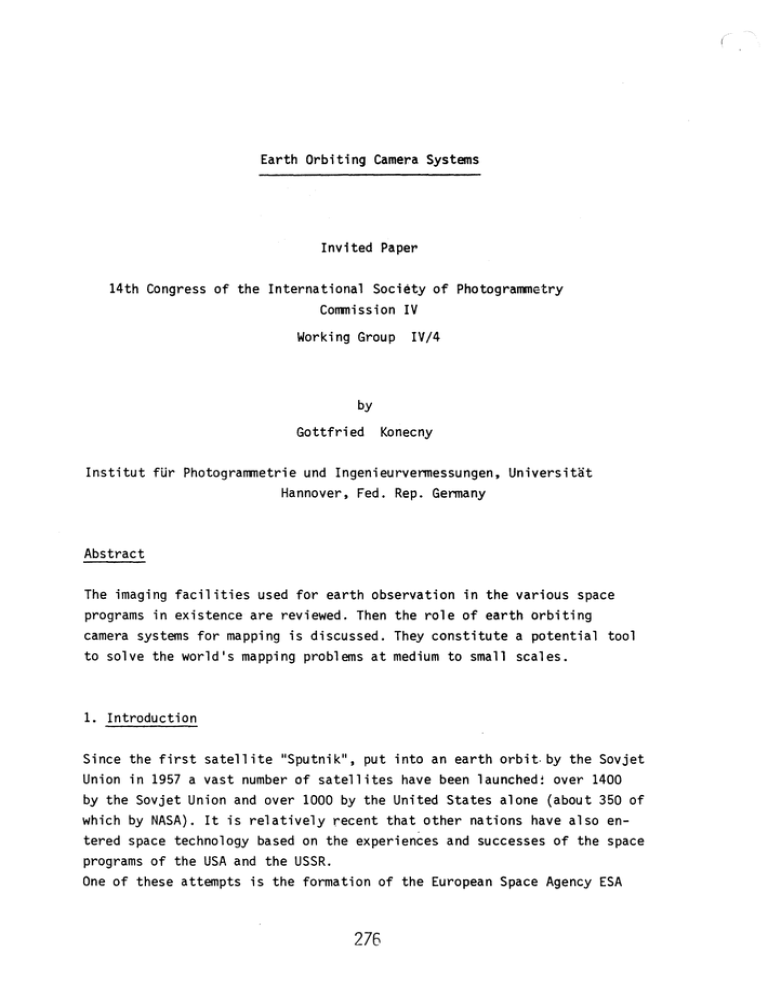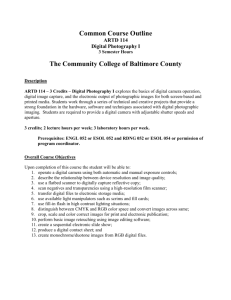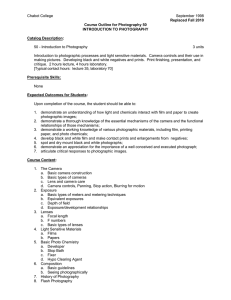Earth Orbiting Camera Systems Invited Paper
advertisement

Earth Orbiting Camera Systems
Invited Paper
14th Congress of the International Society of Photogrammetry
Commission IV
Working Group IV/4
by
Gottfried Konecny
Institut fUr Photogrammetrie und Ingenieurvermessungen, Universitat
Hannover, Fed. Rep. Germany
Abstract
The imaging facilities used for earth observation in the various space
programs in existence are reviewed. Then the role of earth orbiting
camera systems for mapping is discussed. They constitute a potential tool
to solve the world's mapping problems at medium to small scales.
1. Introduction
Since the first satellite "Sputnik", put into an earth orbit. by the Sovjet
Union in 1957 a vast number of satellites have been launched: over 1400
by the Sovjet Union and over 1000 by the United States alone (about 350 of
which by NASA). It is relatively recent that other nations have also entered space technology based on the experiences and successes of the space
programs of the USA and the USSR.
One of these attempts is the formation of the European Space Agency ESA
276
in 1974. It was based on the conviction that pooling of the resources of
the Western European nations would lead to a more effective development.
Other nations now having space programs are Canada, China, France, India
and Japan.
2.
Past Satellite Imagery Missions
Satellites have been of various types:
1.
2.
3.
4.
5.
6.
7.
Weather satellites
Telecommunication satellites
Navigation satellites
Reconnaissance satellites
Geophysical satellites
Earth observation satellites
Manned platforms
For a mapping of the earth's surface, only types 1,4,6 and 7 are of interest. The Tables 1a to d provide a survey of the previous missions using
these satellite types.
name
country
tir.1e
resolution
Tires 1-10
USA
1960-1965
h = 700 km
3,5 km Vidicon
(visible)
ESSA 1-9
USA
1966-1969
h = 1500 km
3,5 km Vidicon
(visible), APT
NOAA 1-
USA
1970
h = 1500 km
0,9 km
(visible & thermal APT)
KOSMOS 1-92
UdSSR
1959-1965
h = 250 km
film cassette
KOSMOS -226
UdSSR
1965-1969
h = 600 km
Vidicon & IR
METEOR 1 ---+
UdSSR
1970-
Vidicon, IR & APT
GEOS
METEOSAT
JAPAN
USA
-ESA
Gr,JS
Table 1a: Weather
GARP
sa~ellites
277
name
time
country
resolution
NIMBUS 1-6
USA
1964 ---+h = 1000 km
ATS 1-4
USA
1966-68
color
h = 36 000 km
LANDSAT 1-2
USA
1972
---+-
LANDSAT 3
USA
1978
---+-
SEASAT 1
1978
USA
Vidicon 1 km
IR-Scanner 8 km
picture element on
the ground 80 m
4 channels
ground picture
element 80 m
4 channels
or
gr.ound picture
elements 40 m
1 channel
picture
element 25m
Radar-X-Band
country
time
resolution
SAMOS 1- rv 80
USA
1962-1972
MIDAS
USA
1967 ---+c = 90 em
IR,UV
h = 3000 km
geostationary visible ranqe
BIG BIRD
USA
1973 ---+h = 150 km
Table 1c: Reconnaissance satellites
278
I
I
I
I
I
:
i'
~round
Table 1 b: Earth observation satellites
name
i
I
15 m
cameras
c = 90 em
film retrieval
1-2 m
c = 1,8 m
cameras
film retrieval
I
I
i
N
'-.!
LO
mission
year
camera
GEMINI 4-7
1965
GEMINI 10-12
1966
APOLLO 7
c
fonnat
200 km
Hasselblad
C.Zeiss-Optics
80 mm
5,7 x 5,7 em
20 Lp/mm
125 mm
Maurer
200 km
80 mm
5,7 x 5,7 em
20 Lp/mm
125 mm
1968
R220 Maurer
225-420 km
80 mm
5,7 x 5,7 em
35 Lp/mm
70 m
APOLLO 9
1969
192-496 km
Hasselblad
C.Zeiss-Optics
80 mm
5,7 x 5,7 em
35 Lp/mm
70 m
SKYLAB (S190A)
1973
ITEK
435 km
152 mm
5,7 x 5,7 em
29 Lp/mm
99 m
SKYLAB (S190B)
1973
ETC Acton
435 km
360 mm
11 ,5 x 11,5 em 25 Lp/mm
38 m
SOJUZ 22-30
since
1976
MKF-6
Jena
250 km
125 km
I
1
Table1d:
H
Manned space platforms
5,5 x 8,1 em
resolution
80 Lp/mm
ground resolut.
25 m
3.
Future Plans for Satellite Imagery Missions
The planned space missions are listed here separately for
the space programs of the USA, of other countries and of ESA.
3.1.
u.s.
spaceborne remote sensing programs
A. Previous Developments as Prerequisites:
1. Space-Shuttle
Re-usable transporter
2. T.D.R.S.S.
Worldwide receiving system via
geostationary satellites
3. Multimodular satellites
Standardized satellites
B. Systems under construction
1 . LANDSAT - D
1982
Thematic mapper:
6 spectral 0.42-2.35 pm
bands
Picture element size
on the ground 30 m
band
1 0-1 2 . 5 pm
Picture element size
on the ground 120m
85 M bits/s data rate
via T.D.R.S.S.
2. Shuttle experiment (O.F.T.)
a) large-format camera (ITEK)
c = 30 em
23 x 23 em size
4000 exposures
pallet
b) SEASAT Radar
(X
&
L band)
C. Planned systems or systems under discussion
1. MAPSAT (U.S.G.S.)
1 band
picture element on
the ground 30-40 m
picutre element on
2 bands
the ground 60-90 m
15 Mbits/s data rate
h = 900 km
280
diode lines (convergent)
picture element on the ground 15 m
2. STEREOSAT (J.P.L.)
3. MULTIMODULAR SATELLITES &LARGE-FORMAT CAMERAS
Life
Parking orbit
Mission orbit
3. 2.
6-9 months
900 km
250 km
Spaceborne remote sensing programs of other countries
USSR - INTERCOSMOS
Soyouz
in operation
MKF-6
FRANCE
SPOT on ARIANE
20 m picture element, 2 spectral bands
10 m picture element, 1 band
250 images storable
under construction
MOS (Marine Observation Satellite)
50 m picture element, visible and thermal
under construction
and planned
LOS (Land Observation Satellite)
30 m picture element
for launch in
1984
1983
1987
PEOPLE'S REPUBLIC OF CHINA
Program of the Jen Hsi-Min Space
Technology Institute
281
planned
3.3.
A.
ESA spaceborne remote sensing program
Previous developments as prerequisites:
1) Manufacture of SPACELAB (E.R.N.O.)
for multi-purpose use in the re-usable NASA space
transporter SPACE SHUTTLE
2) Manufacture of the European launcher ARIANE
B.
Systems under construction
1) SPACELAB-1 Experiment, h = 250 km, orbit inclination 5 7°,
photogrammetric camera
Zeiss RMK 30/23, 2 films = 1000 exposures
Mission duration 1 week
Launch: May 1983
2) SPACELAB-1 Experiment
Microwave remote sensing
in
a)
b)
c)
C.
3 modes:
Microwave scatterometer
Passive thermal sensor
Photogrammetric radar in X-band (9,6
100m picture element (25m desired)
Image width 9 km
GHz)
Planned Systems or systems under discussion
1) COMSS
a.
b.
Coastal Ocean Monitoring Satellite System
ocean color scanner (4 channels line diode, narrow-band)
synthetic aperture radar, 30 m pixel desired but doubtful,
suggested alternative: laser altimeter
2) LASS Land Application Satellite System
a.
b.
(launch 1986)
multispectral scanner (line diode)
synthetic aperture radar
282
(launch 1988 ?)
3)
Sensor Developments
suggested to be undertaken in the Federal Republic of Germany:
A)
Camera Systems
a. development of a 23 x 23 em format mapping camera for
use on a Spaceshuttle pallet
b. adaptation of this camera on a SPAS-multimission freeflyer-platform
B)
C)
Scanners
a.
completion of the diode array MOMS (modular optical multispectral scanner).
b.
construction of a stereo-version of the MOMS {"StereoMoms'') with one array looking forward, a second vertically down and a third aft
Radar
Two frequency synthetic aperture imaging radar
4.
The Role of Earth Orbiting Camera Systems
Since the first manned earth orbiting space missions space photography
has been utilized in the USA as well as in the U.S.S.R.
Cameras utilized in these missions mostly were non-photogrammetric resulting in image scales generally smaller than 1:1000 000. These images
served generally interpretation purposes. NASA made their images of
missions Gemini 4 to 7 (1965), Gemini 10-12 (1966), Apollo 7 and Apollo 9
(1968 and 1969) available for international use.
These images were able to demonstrate, what later automatic image
acquisition systems with scanners, such as Landsat 1, 2 and 3 were
able to achieve from 1972 on. The Landsat-Program has made the countries
of the world aware of the potential of space imagery for the purposes
of thematic mapping of geological features, of vegetation, of hydrological information and of land use. It was soon realized, however, that
283
the spacial resolution of Landsat 1 and 2 of 79 m pixel size (and of Landsat 3 of 30m pixel size) is much too coarse for reliable mapping with
the standard of a topographic map.
Both the U.S.A. and the U.S.S.R. have demonstrated with improved camera
systems in the missions Skylab (1973) and Sojuz (since 1976) that photographic resolutions between 25 to 40 m (corresponding to pixel sizes of
about 10 to 15 m) could be reached. These cameras were photogrammetrically
calibrated and they possessed image motion compensation. The drawback of
these space-photography missions was that the missions were of relatively
short duration, covering only isolated parts of the globe. On the other
hand the formats of the images were not usable in standard photogrammetric
plotting equipment. For that reason the capabilities of space photography
could not be fully demonstrated to the mapping community throughout the
world.
Various attempts are being made internationally to reach higher spatial
resolution with future automatic earth resources satellites.
The success of the Landsat program was in its capability to proviede a
worldwide coverage every 18 days if not inhibited by cloud cover or by
transmission and reception conditions.
Several countries or country groups, among others Canada, Brazil, Zaire
or the European Space Agency have entered agreements with NASA to receive Landsat data using their own receiving stations.
Most countries used these images in analogue form for photographic interpretation of geographical, geological, hydrological, biological or agricultural regional phenomena.
Much better interpretation results were used in multispectral classification of terrain features utilizing the 4 spectral channels of Landsatdata in digital form. While digital treatment of Landsat data was demonstrated to be superior in every respect to analog interpretation, it was
realized at the same time that digital processing of Landsat data is very
time-consuming and very costly. For that reason all received Landsatimages cannot be digitally processed at the moment to give optimal interpretation results.
At the same time the detectability of an object is limited to about 2,5
times the pixel size. Theref~te Landsat 1 and 2 images are only able to
resolve objects with suffici~t contrast with certainty only, if they
are at least 200 m in size.
Since many thematic and especially the topographic requirements call for
detection of objects of a few meters in size only future earth resources
284
satellites are trying to achieve smaller pixel sizes: In the U.S.A. Landsat
D is being designed for a pixel size of 30m. Likewise France has decided
on a pixel size of 30 for the SPOT-satellite.
The proposals in the U.S.A. for the Stereosat-satellite (15m), of the
European Space Agency (COMSS and LASS 30m) and of Japan call for higher
resolution than Landsat 1 and 2.
One of the limiting factors to achieve the desired resolution suitable for
topographic mapping is the data transmission rate. While in a Landsat image
3200 image elements are digitized every 50 m along the scan (yielding
an equivalent pixe! size of 79 m) with 8 bit grey level information for
each of the 4 spectral channels. With one scan every 79 m with a velocity
of 7.7 km/sec 97 scans must be made per second. To transmit these a data
rate of 10 M bit/sec is required.
For Landsat D a data rate of 85 M bit/sec will be necessary. The present
technological limit is 200M bit/sec disregarding cost considerations.
To reach the potential of current photography achievable with photogrammetric cameras, however, a data rate of 900 M bit/sec would be required. During
the next decade it does not appear to be feasible to reach this rate economically.
Space photography therefore surpasses the capabilities of automatic sensors to provide data to solve cartographic problems at medium and small
scales.
5.
~lanned
and Suggested Space Photography Missions
Survey of mapping progress in the world published in 11 World Cartography 11
no. XIV indicate that current mapping methods utilizing aerial photography
yield a too slow progress. The progress is not only a function of the area
to be mapped but also in relation to the number of photographs to be utilized for mapping. Systematic photographic coverage from space leads to
utilization of far fewer photographs, far fewer control requirements and
should therefore lead to a faster progress in mapping.
The requirements for space photography are that
1. a sufficient resolution is achieved to detect all objects of interest
2. a specified positional accuracy can be achieved commensurate with
mapping standards
3. a specified elevation accuracy can be achieved commensurate with
mapping standards.
285
These requirements vary for the different mapping scales and for different
types of terrain.
Based on these specific requirements a suitable space mapping system utilizing photographic cameras can be designed. The Institute of Photogrammetry at the University of Hanover in collaboration with the German Space
Agency (DFVLR) has been engaged in a study of a suitable space photographic
system in the socalled "Atlas"-Program.
The "Atlas"-program is composed of three phases:
Phase A:
Utilization of a standard mapping camera in space to acquire
photographic imagery from a low orbit out of a pressurized
manned cabin.
Phase B:
Use of an improved camera (optics image motion compensation)
from a pressurized unmanned container.
Phase C:
Use of the container in a free-flying retrievable unmanned satellite.
While phase Band Care at the proposal stage, phase A will be realized
as an experiment during the first European Spacelab mission now scheduled
to be carried into orbit in the NASA Space Shuttle Program in May 1983.
6.
Spacelab One Metric Camera Experiment
The government of the Federal Republic of Germany has placed at the disposal of the European Space Agency (E.S.A.) a Carl Zeiss. Oberkochen,
RMK 30/23 photogrammetric mapping camera, which has been modified to meet
space requirements, as a European space facility. While the experiment
is funded by the government of the Federal Republic of Germany, the DFVLR
is responsible for procurement and engineering carried out by Zeiss, ERNO,
MBB and Kaiser Trede to operate the camera electronically by ground commands
a~d to accomodate it in the Spacelab module. E.S.A. cares for setting up
experimentation in countries interested. It has issued a call for experiment proposal.
The response was overwhelming. Over 100 Institutions in all continents
have expressed a worldwide interest to experiment with the imagery.
Based on these proposals a timeline for areas to be photographed has been
drawn up subject to cloud cover conditions permitting photography.
286
Altogether 2 film magazines with a total of 1100 photographs can be exposed. In order to select the most suitable film types a joint cooperative test has been carried out utilizing high altitude photography involving aircraft of IGN of France and the DFVLR. Inthe evaluation the
French Agencies CNES and IGN, the German Agencies DFVLR and IFAG as well
as the University of Milano and Hannover were involved. They have already indicated that a photographic resolution of about 20 m (corresponding
to a pixel size of 8 m) can be reached from Spacelab 1 utilizing black
and white film. Infrared false color films yield slightly lower, but
still acceptable resolution, while the color films available cannot be
recommended.
The photographs will be taken with 80% or with 60 % overlap. The 80 %
overlap permits to utilize every 5th photo for a very large base-height
ratio, yielding high elevation accuracy in plotting subsequent for image
portions. The proposals have indicated that the images will be subject
to a wide range of investigations and methods ranging from topographic
to thematic mapping in various disciplines such as geography, geology,
forestry, land use planning, agriculture, hydrology, coastal engineering
and oceanography. Concerning the methods to be used all known mapping
techniques are included: aerial triangulation, analog mapping, the use
of analogue plotters, rectification, orthophoto-mapping, standard-photo; nterpreta t ion.
The experiments should give a clear indication over a wide area of the
world, whether the further steps of the "Atlas" program should be pursued
and with which energy.
7.
Large Format Camera on Space Shuttle
In the United States similar experiences will be obtained with the Large
Format Camera, LFC, built by Itek Corporation for NASA. It is to be utilized on Space Shuttle as an OFT-test facility. The first mission now planned
for 1983 will be a low inclination mission, giving photographs of tropical
and subtropical areas only.
Suggestions have been made to supplement the LFC on subsequent missions
with two (forward and aft) panoramic cameras used on the later Apollo moon
missions.
287
8. The MKF-6 Sojuz missions
Of special interest to the international community are the MKF-6 multispectral photographs made from all current Sojuz-missions. It would be a
great service to photogrammetry if such test imagery could be made available to an international ISP working group.
9.
Conclusion
The presently operating and planned earth orbiting camera systems will
most likely confirm, that space photography is a potential tool to cope
with the world S mapping problems at medium and small scales, and that its
use will surpass the capability of automatic sensors in ground resolution,
simplicity, accessib'ility, instrument-infrastructure and cost.
1
References:
(1) G.Konecny, M.Schl"Oeder: Einsatz einer ReihenmeBkammer im Weltraumlaboratorium Spacelab
Allgemeine Vermessungsnachrichten 1977/10
11
11
(2) G.Konecny, M.Schroeder
Einsatz von photographischen MeBkammern im Weltraum
Allgemeine Vermessungsnachrichten 1979/7
11
(3) F.J.Doyle
A Large Format Camera for Shuttle
Photogrammetric Engineering 1979/1
11
11
11
(4) H.Kautzleben et al.
First Results of the Experiment Raduga for Photographic Remote
Sensing
Proceedings ESA, SP-134; Earth Observations from Space and Management of Planetary Resources, Toulouse 1978
11
11
(5) M. Schroeder, G.Konecny
Use of a Metric Camera in Spacelab
11
288
11
,
ibid.
(6) G.Konecny, H.P.'Bahr, W.Reil, H.C.Schreiber
11
Use of Spaceborne Metric Cameras for Cartographic Applications"
Report of Institut fUr Photogrammetrie und Ingenieurvermessungen,
Universitat Hannover, Heft 5, 1979
289




